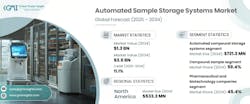Automated sample storage systems: Enabling precision and efficiency in biobanking and drug discovery
The global automated sample storage systems market was valued at approximately USD 1.3 billion in 2024 and is projected to witness robust growth, reaching USD 3.6 billion by 2034.
This reflects a strong compound annual growth rate (CAGR) of 11.1% from 2025 to 2034, underscoring the expanding role of automation and digital transformation in modern laboratory infrastructure.
This accelerating growth is primarily fueled by the increasing demand for biobanking and the preservation of biospecimens, alongside the digital transformation of clinical and research laboratories, and heightened activity in drug discovery and development. As research institutions, pharmaceutical companies, and healthcare providers handle increasing volumes of biological samples, the need for secure, high-throughput, and error-free storage solutions is driving adoption of automated sample storage technologies.
A core driver of this automated sample storage systems market expansion is the proliferation of biobanking initiatives aimed at long-term storage of human tissues, DNA, plasma, and other biospecimens for genomic, proteomic, and clinical research. As personalized medicine becomes more prevalent, the demand for comprehensive, well-organized sample libraries is surging. Automated systems offer a scalable, traceable, and contamination-free environment for storing sensitive biological materials, enabling researchers to preserve sample integrity over extended periods.
The digital evolution of laboratory processes further contributes to market momentum. Research and clinical laboratories are increasingly integrating automated systems with Laboratory Information Management Systems (LIMS) and cloud-based platforms to optimize data flow, track samples in real-time, and ensure regulatory compliance. These systems reduce human error, enhance workflow efficiency, and facilitate centralized access to valuable specimen data—key requirements in today’s data-driven research landscape.
Moreover, the ongoing expansion of pharmaceutical R&D pipelines, particularly in biologics, vaccines, and personalized therapeutics, has intensified the need for high-capacity, automated storage solutions. From preclinical testing through late-stage clinical trials, pharmaceutical and biotech firms rely on these systems to store thousands of samples under precisely controlled environmental conditions. Automated sample storage not only accelerates discovery workflows but also ensures reproducibility and consistency in experimental outcomes.
Technological innovation is also playing a transformative role in shaping the automated sample storage systems market's future. The latest automated sample storage systems are equipped with advanced robotics, climate-controlled compartments, barcoding and RFID integration, and AI-powered inventory tracking. These features are not only enhancing operational efficiency but also reducing sample retrieval times and improving system scalability—making them ideal for high-volume biorepositories and fast-paced drug development environments.
Despite the optimistic outlook, the market does face certain challenges. High upfront costs, infrastructure requirements, and system complexity can limit adoption among smaller laboratories or institutions with constrained budgets. Additionally, data security and integration hurdles—especially when linking automated systems with existing digital infrastructure—may pose technical and regulatory concerns.
Nonetheless, the global automated sample storage systems market remains poised for dynamic growth. As the life sciences sector continues to prioritize efficiency, data integrity, and scalability in research and diagnostics, these systems are becoming essential components of modern laboratory operations. By enabling secure, automated, and intelligent sample management, they are set to play a pivotal role in the advancement of precision medicine, biomedical research, and next-generation drug discovery.

